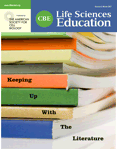Stem Cell Biology Should Be Taught in High Schools
Stem cells have the potential to address critical, unmet medical needs, from diabetes to Alzheimer's disease to Parkinson's disease. However, beginning with the first report of human embryonic stem cells in 1998, arguments have raged over the generation and use of stem cells and their ethical implications. A major problem in the current environment is the absence of broad-based education on the subject. This is exacerbated by the fact that most biology textbooks provide little or no coverage of the topic. Science teachers may find it difficult to contribute effectively to prepare the next generation of adults and decision-makers for engagement in an already lively public debate over stem cells. As a result, most citizens complete their public secondary educations with little or no formal education about stem cells, and they rely on what they hear from peers, parents, news media, or other sources. Therefore, we are ill prepared to engage in societal deliberation based on an understanding of the ethical and scientific landscape. Making future decisions about the use of these technologies is likely to be difficult, but it will be even more difficult if citizens and policymakers do not understand the fundamental science and are consequently unable to evaluate claims made on scientific grounds.
We argue that stem cell biology should be taught in high schools. Because compulsory state-supported public education ends at the secondary level, we think that this education cannot be postponed until college science studies. Although existing resources can be used to teach some of the content, there is an urgent need to revise and adapt materials to incorporate this new science. Until formal curricular modules are developed and stem cell biology routinely is part of mainstream textbooks and teacher professional preparation programs, the education community is urged to find ways to introduce learning and discussion of stem cells into existing biology curricula.
Here, we offer a short-term suggestion anticipating that biology curricula and texts will be updated eventually to address this important field of science. One strategy for addressing the current situation would be to develop teaching modules that introduce stem cell biology while simultaneously addressing existing curricular needs in basic biology education. The development and implementation of such stem cell curricular modules could facilitate timely integration of this subject into science programs. This might be accomplished in a sequence of lessons that use modern teaching modalities to introduce stem cell biology while providing education on basic principles of biology. Table 1 outlines one possible approach: a unit that would require 2–3 wk to teach. The proposed schedule addresses several important aspects of the National Science Education Standards, with particular emphasis on inquiry through laboratory investigation, bioinformatics, small-group investigation, and problem-based learning, in addition to conventional direct instruction.
| Module | Class periods | Topics |
|---|---|---|
| I | 1 | Guiding question: What are the fundamental concepts of developmental biology? Lecture: meiosis, fertilization, embryonic stages |
| II | 2 | Guiding question: What is cellular differentiation and how is it regulated? Laboratory investigation, e.g., sea urchin embryology lab activity |
| III | 1 | Guiding question: What are stem cells, their sources, and the technologies for studying them? Lecture or computer-aided instruction: introduction to stem cell biology (content scope approximately equivalent to that of National Institutes of Health's Stem Cell Basics (http://stemcells.nih.gov) |
| IV | 1 | Guiding question: What genes are involved in controlling embryonic development? Bioinformatics investigations: introduction to the National Center for Biotechnology Information (www.ncbi.nlm.nih.gov) |
| V | 2 | Guiding question: What is the potential of stem cell science for the treatment of degenerative disease? Small-group research: identify and describe a disease that is currently being researched with stem cell biology |
| VI | 2 | Guiding question: What is the scientific potential for treatment of a degenerative disease by using stem cells? Problem-based learning with further use of bioinformatics and other research resources: What types of stem cell offer promise for treatment of this disease? Why? Multimedia presentations: group reports on findings |
| VII | 1–6 | Guiding question: What are the ethical issues concerning the use of stem cell therapies? Identify differing stakeholders, their concerns, and how their concerns relate to different cell sources and potential uses. Possible instructional modalities: “what-if” scenarios (e.g., Public Broadcasting Service videos), case analysis (e.g., stem cells and ethics), role-playing exercises (e.g., Stem Cell Network at http://www.stemcellnetwork.ca/engage/index.php) |
With this letter, we hope to illuminate this important issue, offer a short-term solution, and advocate inclusion of stem cell biology in high school textbooks.



